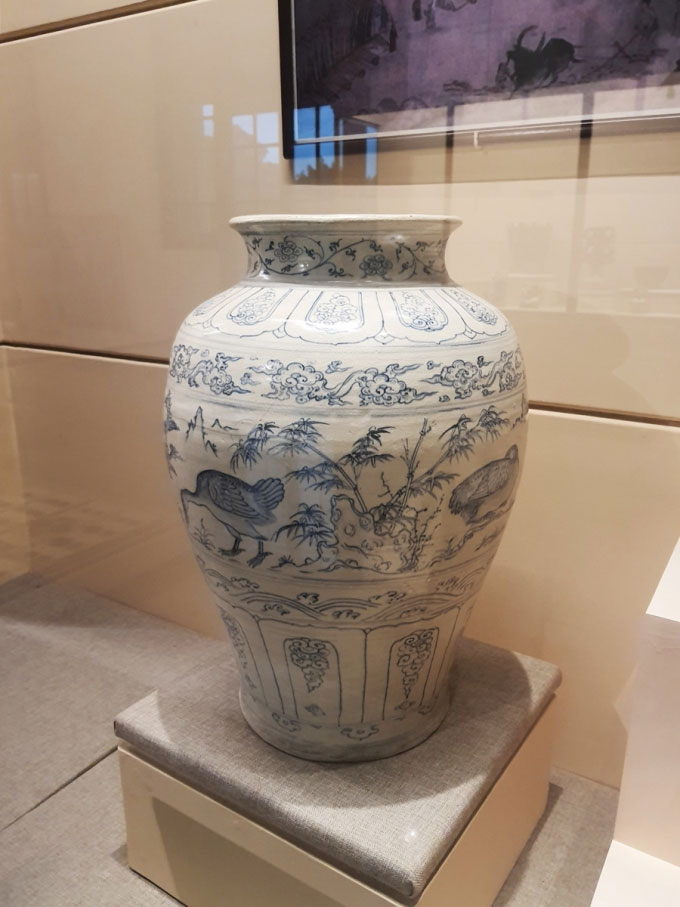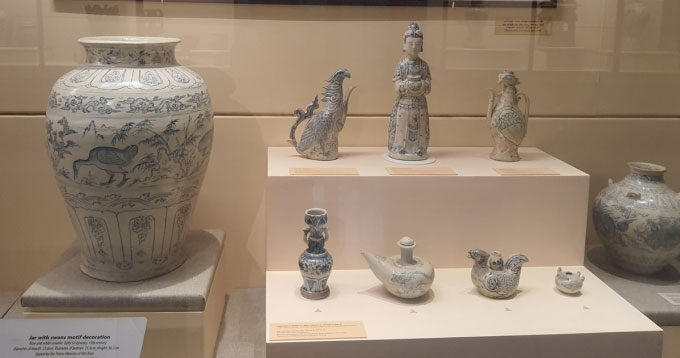“Blue Flower Ceramic Vase with Swan Design” – a national treasure – was discovered during the excavation of a sunken ancient ship in Cu Lao Cham Sea.
This piece was recognized as a national treasure in 2012 and is displayed alongside the collection of ancient ceramics from Cu Lao Cham, dating back to the 15th century, in the “Le – Mac Dynasty (1427-1788)” exhibition on the second floor of the National Museum of History. According to the heritage records from the Cultural Heritage Department, this vase is the largest ceramic artifact found in the unique collection excavated from the sunken ship in Cu Lao Cham, Hoi An, Quang Nam, between 1999 and 2000. This product reflects the pinnacle of technique and artistry in ceramic manufacturing during the Early Le period, representing Vietnam’s export ceramics.
The vase has a tall, bulging shoulder, and a tapered body that narrows towards the base, creating a slender and elegant appearance, showcasing the distinctive features of Early Le ceramic shaping techniques. On a white glaze background, the patterns are painted with delicate shades of blue. The neck of the vase features bands of chrysanthemum flowers, followed by bands of lotus petals within stylized cloud swirls. The body of the vase depicts the characteristic landscape of the Northern Delta with fields, bamboo, and grasses. This is followed by bands of waves and cloud patterns.
The unique aspect of this ceramic vase is the depiction of four swans engaged in different activities: flying, calling, sleeping, and foraging, symbolizing Phi – Minh – Túc – Thực – a familiar theme in ancient ceramic motifs. The swan spreading its wings (Phi) represents freedom and advancement. The one stretching its neck to call (Minh) implies a bright future and vast prospects. The bird tucking its head to sleep (Túc) symbolizes rest and abundance. The one foraging (Thực) represents warmth and wealth. This is a play on words from ancient times, using imagery and homophones to express wishes for a bright future and a prosperous life.

The vase has a mouth diameter of 23.8 cm, a base diameter of 25.8 cm, and a height of 56.5 cm. (Photo: Hieu Nhan)
According to documents from the National Museum of History, the vase is a representative of the blue-painted white ceramics, commonly known as blue flower ceramics, which appeared during the Tran Dynasty in the 14th century and has continuously developed to the present day.
The vase was produced in Chu Dau village (now part of Thai Tan, Nam Sach, Hai Duong) – one of the largest ceramic production centers in the country, established in the 14th century and flourishing in the 15th and 16th centuries. This place specializes in producing high-quality ceramics for the nobility and for export. The decorative themes break away from the classic Chinese motifs, expressed in a free, creative manner, rich in folk art, reflecting the essence of Vietnamese rural life, especially in the Northern Delta region.
However, Associate Professor Dr. Bui Minh Tri – Director of the Institute for Imperial City Research – believes that the vase was produced in the Thang Long royal kiln. Excavations at the Thang Long Imperial Citadel have uncovered many ceramic fragments with similar patterns.
Dr. Pham Quoc Quan – Member of the National Heritage Council and former Director of the National Museum of History – noted that aside from its royal nature, the vase is the largest in the Early Le ceramic system. “It is perfect in glaze and demonstrates a high level of firing”, he stated.
According to him, the artisans displayed remarkable skill in observing the various postures and movements of the swans. The feathers, eyes, and beak are depicted in a meticulous painting style (detailed and realistic). The landscape is painted in a free brushwork style (creative and expansive). The vase uses cobalt blue glaze, creating a unique painting style.
Dr. Nguyen Dinh Chien – former Deputy Director of the National Museum of History – remarked that the vase is called the swan vase because its most prominent decoration features four swans. “One of the outstanding values of this vase is its uniqueness. According to agreements with foreign experts during the excavation of the Cu Lao Cham ancient ship, valuable and unique items will belong to our country. This blue flower ceramic vase with swan design is among those unique artifacts.”
In the book 2,000 Years of Vietnamese Ceramics, blue flower ceramics appeared in the 14th century, thrived in the 15th century, and were exported to Southeast Asia with various special product types. The early blue flower ceramic products included teapots, jars, bowls, vases, plates, and boxes… decorated with bamboo, lotus, chrysanthemum, etc. Many publications in Thailand, Indonesia, and Japan have documented various forms of blue flower ceramics. Notably, the Topkapi Palace Museum in Istanbul, Turkey, displays a blue flower vase with an inscription clearly stating the year and place of production: “In the eighth year of Dai Hoa, painted by a craftsman from Nam Sach County, Bui family.” (The artisan from the Bui family in Nam Sach County painted it in the eighth year of Dai Hoa (1450)).

The blue flower vase with swan design (left) displayed alongside the collection of ancient ceramics from Cu Lao Cham at the museum. At the time of discovery, the ship was located at a depth of 70-72 meters underwater. The remaining part of the ship is 29.4 meters long and 7.2 meters wide. The excavation was conducted over three years (1997-2000) with 240,000 artifacts recovered. (Photo: Hieu Nhan)


















































